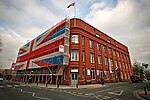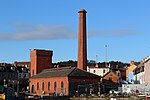Vauxhall Bridge, Bristol

Vauxhall Bridge is a footbridge in Bristol, England, that crosses the New Cut of the River Avon. At its northern end, the bridge also passes over the Bristol Harbour Railway line from Ashton Gate to Wapping Wharf, which runs along the bank of the New Cut at this point. The bridge was opened in 1900, replacing the Vauxhall ferry. On 30 December 1994, it was Grade II listed.When the bridge was built, the New Cut was still in use by shipping to and from Bathurst Basin and the various shipyards that adjoined the cut, and consequently the bridge was built as a swing bridge. It is approximately 270 feet (82 metres) long and 11 feet (3.4 metres) wide, with a swinging section of 158 feet (48 metres) in length. Navigation ceased on the New Cut in the 1930s, and the bridge was last swung in 1936.
Excerpt from the Wikipedia article Vauxhall Bridge, Bristol (License: CC BY-SA 3.0, Authors, Images).Vauxhall Bridge, Bristol
Cumberland Road, Bristol Spike Island
Geographical coordinates (GPS) Address External links Nearby Places Show on map
Geographical coordinates (GPS)
| Latitude | Longitude |
|---|---|
| N 51.446388888889 ° | E -2.6116666666667 ° |
Address
Vauxhall Bridge
Cumberland Road
BS1 6TT Bristol, Spike Island
England, United Kingdom
Open on Google Maps







